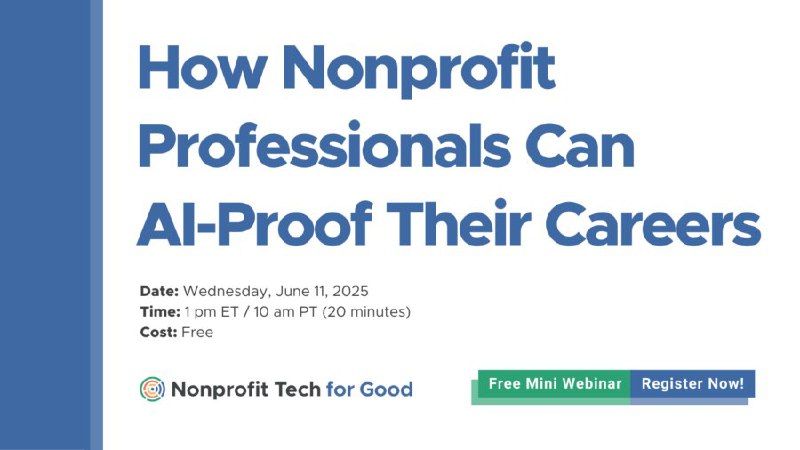Unlock Your Future: AI-Proof Your Nonprofit Career! 🌟
Embracing AI: A New Era for Nonprofit Professionals
As we stand on the precipice of technological evolution, the nonprofit sector faces both challenges and opportunities brought about by generative AI and the advancement of artificial general intelligence (AGI). Imagine a world where nonprofit professionals are not just recipients of AI tools but are skilled navigators of innovative technologies that redefine their roles and amplify their impact.
The Reality of Nonprofit Work Today
In the fast-paced environment of nonprofit organizations, professionals often juggle multiple roles, from fundraising to community outreach. The introduction of AI into this landscape offers transformative potential, but how can these changes be leveraged effectively? Let’s explore a few hypothetical scenarios to envision the future of nonprofit work.
Scenario 1: Continuous Learning and Adaptation
Imagine an environment where nonprofit professionals engage in lifelong learning facilitated by AI. With AI-driven platforms, staff can access personalized training modules tailored to their needs. For example:
- Scenario: A nonprofit dedicated to environmental conservation utilizes an AI platform to assess individual learning styles and suggests relevant courses on digital fundraising and social media outreach.
- Outcome: Increased proficiency leads to successful campaigns, generating more funds to support initiatives.
Scenario 2: Predictive Analytics for Impact Measurement
Consider the potential of predictive analytics in grant writing and project funding. Nonprofits can harness data to forecast funding trends, tailor their proposals, and maximize their chances of success:
- Scenario: A health organization uses predictive analytics to understand which grant proposals are most likely to succeed based on historical data.
- Outcome: By prioritizing bids with high success rates, they can optimize their grant portfolio and secure vital funding.
Scenario 3: Automated Engagement and Reporting
Imagine if donor engagement was facilitated through AI-powered chatbots that provide instant responses and personalized messages:
- Scenario: A local food bank implements an AI chatbot that interacts with potential donors on their website.
- Outcome: The food bank sees a 25% increase in donations as the chatbot answers questions and builds connections with donors 24/7.
The Road Ahead: Implementing AI in Nonprofits
The scenarios outlined raise vital questions about the future role of nonprofit professionals. How can organizations effectively implement these technologies to derive measurable benefits? Below are actionable steps for making this transition:
- Invest in Training: Provide resources for professional development focused on AI literacy.
- Adopt AI Tools: Identify AI tools that align with your organization’s goals. Start with small tools, such as chatbots or donor management systems.
- Measure Outcomes: Regularly assess the impact of AI tools on efficiency and ROI, ensuring that adjustments are made based on findings.
- Encourage Collaboration: Foster a culture of collaboration where team members can share insights and best practices regarding AI usage.
As nonprofits move towards a future empowered by AI, the potential benefits are vast. By embracing these innovative technologies, organizations can streamline operations, enhance donor relationships, and ultimately increase their overall impact.
Conclusion
With the proliferation of AI technologies transforming nonprofit work, the potential to enhance capabilities and efficiencies is immense. Adapting to these changes not only equips professionals with the necessary skills to remain relevant but also positions organizations to thrive. Take the first step toward a tech-savvy future by scheduling a consultation with our team today and unlock the possibilities that AI has to offer for your nonprofit!
**How it may benefit the business:**
Integrating AI technologies enhances efficiency, personalizes donor engagement, and optimizes grant proposals, ultimately leading to increased funding and improved organizational effectiveness.
**Provide examples of the average benefits’ ROI:**
– Implementing AI tools can result in a 20-30% increase in donor engagement rates, translating to a measurable increase in donations.
– Predictive analytics can lead to a 15% increase in successful grant proposals, which directly supports mission-driven initiatives.
**What actions should the business take to implement these benefits:**
1. Invest in AI training for staff to promote understanding and utilization of AI tools.
2. Start with small, manageable AI applications that fit within current operational structures.
3. Establish metrics to evaluate the impact of AI on fundraising, donor engagement, and overall effectiveness.
4. Foster a culture of innovation where team members collaborate on finding new uses for AI technologies.
**Short summary and call-to-action (CTA):**
The integration of AI into nonprofit work presents an unparalleled opportunity for professionals to enhance their effectiveness and operational capacities. By building AI literacy and adopting innovative tools, organizations can secure a bright future for their missions. Don’t wait—schedule a consultation with our team today to explore how we can help your nonprofit thrive in the age of AI!
Source


